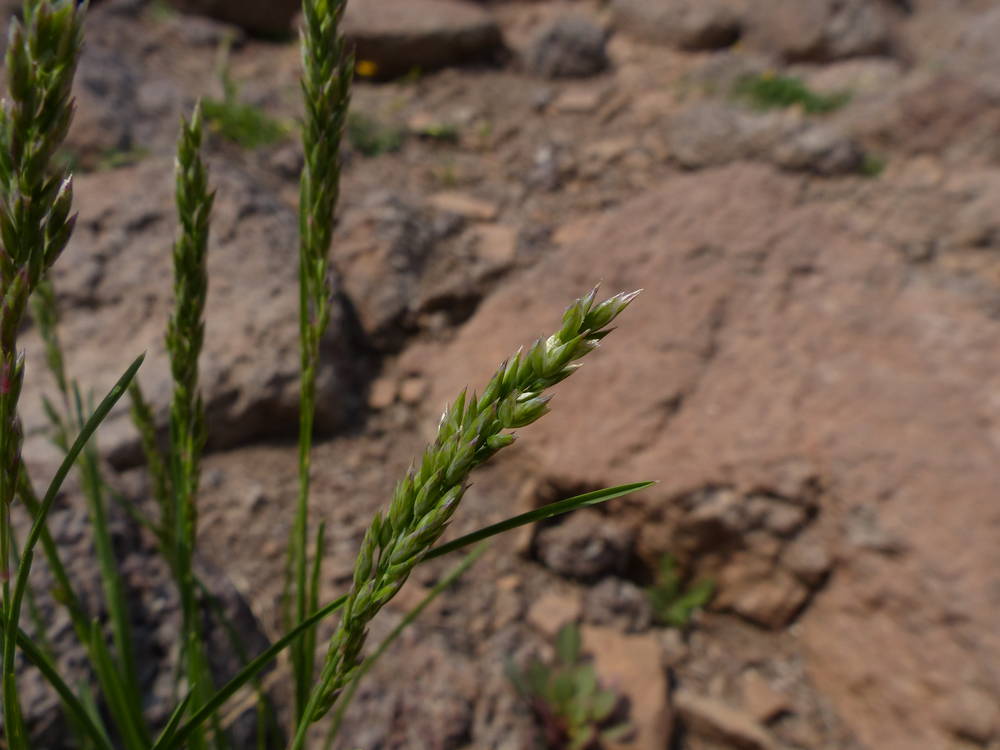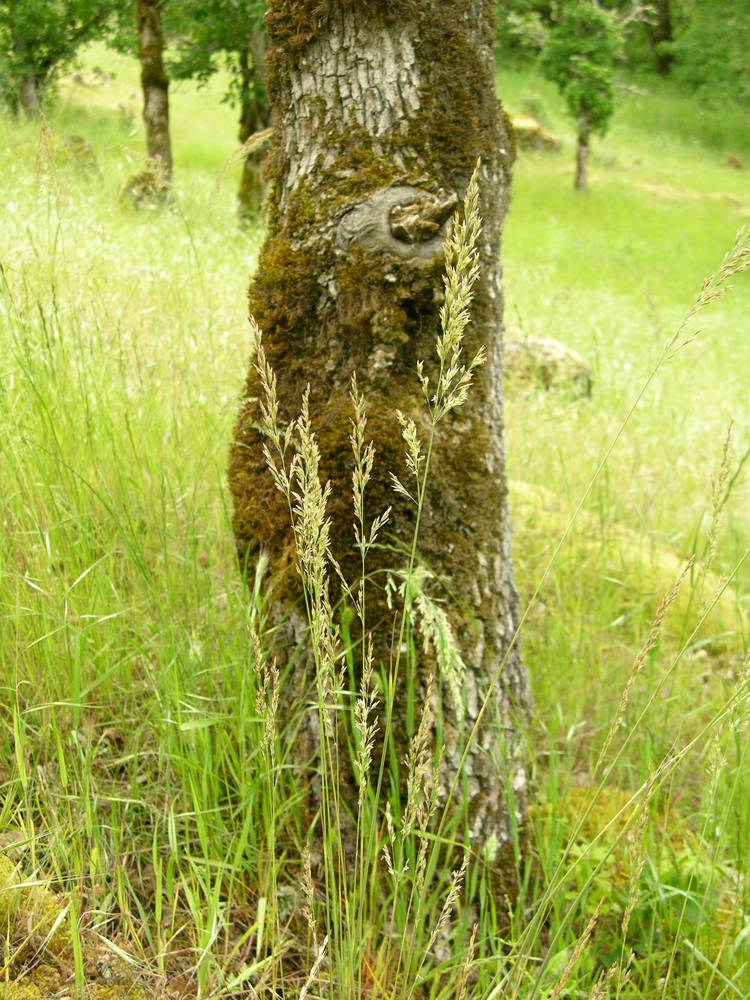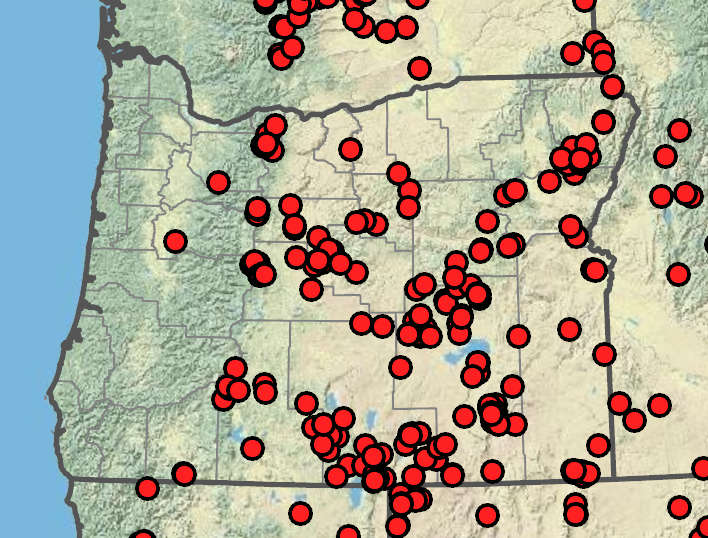Poa cusickii
Poa secunda
Cusick's bluegrass
secund bluegrass
0.5–1.8 mm thick;
nodes terete, 0–2 exserted.
slender to stout;
nodes terete, 0–2 exserted.
intravaginal or intra- and extravaginal.
intra- and extravaginal.
sheaths closed 25–75% of their length, bases of basal sheaths glabrous;
collars smooth or scabrous, glabrous, ligules of cauline leaves 1–3(6)mm;
tips truncate to acute, ligules of sterile shoots 0.2– 0.5(2.5)mm;
tips usually truncate;
blades involute to flat, 0.2– 3.5 mm wide; all about equal or the upper ones slightly reduced in length;
upper surface usually densely scabrous or hispidulous to softly puberulent, infrequently nearly smooth and glabrous;
lower surface smooth or scabrous; uppermost blade 0.5–5(6)cm.
sheaths closed to 25% of their length, bases of basal sheaths glabrous;
collars smooth or scabrous, glabrous;
ligules 0.5–6(10)mm;
blades flat, folded, or involute, 0.4–3(5) mm wide, green to strongly glaucous; thin; soft and soon withering, or thick; firm and persisting; smooth, or scabrous mainly over the veins;
blades gradually reduced distally or the middle blades longest; uppermost blades 0.8–10(17)cm.
usually erect, tightly or loosely contracted, narrowly lanceoloid to ovoid, 2–10(12) cm;
spikelets 10–100;
branches erect or steeply ascending, 0.5–4(5)cm long, 1–3(5) per node, with 1–15 spikelets.
erect or somewhat lax, narrowly lanceoloid to ovoid, usually contracted; more or less open in flower, infrequently remaining open at maturity, usually moderately congested, 2–25(30) cm;
spikelets 10–100+;
branches usually erect or ascending, infrequently spreading at maturity; (0.5)1–8(10) cm, 1–3 per node, with (1)2–20(60+) spikelets in distal 50–67%.
broadly lanceolate to narrowly ovate; to 3 times as long as wide; (3)4–10 mm;
florets 2–6;
rachilla internodes 0.5–1.2 mm long.
usually narrowly lanceolate; more or less terete to slightly laterally compressed; (3.8)4–5 times as long as wide; (4)5–10 mm;
florets (2)3–5(10);
rachilla internodes usually 1–2 mm long; smooth to scabrous.
lanceolate;
lower glumes 3-veined, distinctly shorter than the lowest lemma.
broadly lanceolate;
keels indistinct;
lower glumes 3-veined.
glabrous or with short; sparse, sometimes diffuse cobwebby hairs less than 25% of the lemma length.
glabrous, or with a line of crisp or slightly sinuous hairs 0.1–0.5(2) mm long around the base.
lanceolate to broadly lanceolate; (3)4–7 mm, distinctly keeled, membranous; smooth or sparsely to densely scabrous, glabrous throughout, or keels and/or marginal veins softly puberulent near the base;
tips acute.
lanceolate to narrowly lanceolate or slightly oblanceolate, 3.5–6 mm, usually weakly keeled, glabrous throughout or keels and marginal veins softly puberulent to short-villous; area between veins smooth or scabrous, glabrous; short-villous, crisply puberulent, or loosely softly puberulent over the basal 67%;
hairs usually 0.1–0.5 mm long;
margins strongly inrolled below, broadly scarious above, glabrous;
tips obtuse to broadly acute; blunt or pointed.
vestigial and 0.1–0.2 mm, aborted late in development, or well developed and 2–3.5 mm.
1.5–3 mm.
Poa cusickii
Poa secunda
4 subspecies.
Poa cusickii is a common upland bluegrass with a dense inflorescence. It is usually densely cespitose, though some plants may have short rhizomes. Similar P. fendleriana has reduced uppermost flag blades, and lemmas with silky hairs on the keels and marginal veins. Poa leibergii has narrower leaves and usually longer ligules. Poa wheeleri can be misidentified as P. cusickii if the specimen is collected without its distinctive scabrous leaf sheaths. Poa pringlei, restricted to southwestern Oregon near the California border, has longer ligules, sheaths closed to about a third their length, and glabrous (to scabrous) lemmas. It is dioecious, whereas P. cusickii plants are bisexual or entirely pistillate.
2 subspecies.
Poa secunda is a common, highly variable, densely cespitose grass mainly of uplands. The spikelets are terete to slightly compressed, and the lemmas are more or less rounded over the back and usually hairy to scabrous throughout. Poa stenantha can be very similar, but its lemmas are a bit more strongly keeled and have hairs only on the veins. Callus hairs, if present, are 0.2–2 mm long. Hybrids between P. secunda and P. pratensis (P. × limosa) occur in moist, alkaline meadows in southeastern Oregon. They resemble P. secunda but are more or less rhizomatous and may have more strongly keeled lemmas. Hybrids with P. nervosa, called P. × multnomae, occur in the Columbia Gorge. They have more open panicles and generally grow in moister habitats than P. secunda. Puccinellia lemmonii and Poa secunda are superficially similar, but Puccinellia lemmonii has lower glumes that are less than 50% as long as the lowest lemma, and it grows in more strongly alkaline meadows and flats that are generally wet in spring. Poa secunda is a highly variable taxon. Its combination of asexual and sexual seed production produces multiple widespread, morphologically consistent forms that are sympatric. Many of these variants have been treated as species. However, intermediates can be found between all of them. Here we gather these forms into two categories treated as subspecies.
Rob Soreng, Barbara Wilson, Richard Brainerd, Nick Otting
Rob Soreng, Barbara Wilson, Richard Brainerd, Nick Otting
- Local floras:
BC,
CA,
OR,
WA
- Local Web sites:
CalFlora,
CalPhotos,
Flora NW,
PNW Herbaria
WildflowerSearch
iNaturalist (observations)
USDA Plants Database
- LBJ Wildflower Center
- SEINet
- Plants of the World Online
- Encyclopedia of Life
- Wikipedia
- Google Image Search
- Local floras:
BC,
CA,
OR,
WA
- Local Web sites:
CalFlora,
CalPhotos,
Flora NW,
PNW Herbaria
WildflowerSearch
iNaturalist (observations)
USDA Plants Database
- LBJ Wildflower Center
- SEINet
- Plants of the World Online
- Encyclopedia of Life
- Wikipedia
- Google Image Search





